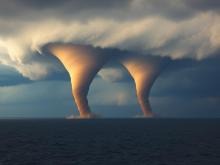Researchers with UBC Physics and Astronomy have overcome a 20-year scientific impossibility, discovering a way to control the number of electrons on the surface of high-temperature superconductors. The new technique has the potential to drive advances in fuel cells, lossless power lines, quantum computer chips, and other applications.
"This opens the door to systematic studies not just of high-temperature superconductors, but many other materials where surfaces and interfaces control the physical properties," says project lead Andrea Damascelli, Associate Professor with the department and Canada Research Chair in the Electronic Structure of Solids.
The new technique--considered impossible for the past two decades--deposits potassium atoms onto the surface of a piece of superconducting copper oxide. The approach allowed Damascelli's team to continuously manipulate the number of electrons on ultra-thin layers of material.
Electrons have been observed to re-arrange on the surfaces of superconducting and ultra-thin materials, taking on very different properties from the rest of the material. Until now, these changes have made the materials impossible for scientists to study.
"It’s become clear in recent years that this phenomenon is both the challenge and key to making great strides in superconductor research," says Damascelli.
Superconductivity--the phenomenon of conducting electricity with no resistance--occurs in some materials at very low temperatures. High-temperature superconductors are capable of conducting electricity with little or no resistance in temperatures as high as -140 degrees Celsius.
The superconductors Damascelli’s team experimented on are the purest samples currently available and were produced at UBC by physicists Doug Bonn, Ruixing Liang and Walter Hardy.
Part of the study was carried out at the Advanced Light Source synchrotron in California. In the future, the design and study of novel complex materials for next-generation technologies will be carried out at the Quantum Materials Spectroscopy Center currently under construction at the Canadian Light Source in Saskatoon under Damascelli’s leadership.
Musqueam First Nation land acknowledegement
We honour xwməθkwəy̓ əm (Musqueam) on whose ancestral, unceded territory UBC Vancouver is situated. UBC Science is committed to building meaningful relationships with Indigenous peoples so we can advance Reconciliation and ensure traditional ways of knowing enrich our teaching and research.
Learn more: Musqueam First Nation
Faculty of Science
Office of the Dean, Earth Sciences Building2178–2207 Main Mall
Vancouver, BC Canada
V6T 1Z4


